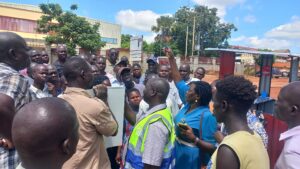Water is a critical input in preventing the spread of the novel Coronavirus COVID-19 because it is essential for handwashing. The Managing Director of National Water and Sewerage Dr Eng. Silver Mugisha answers frequently asked questions about the preparedness of NWSC to continue service provision, access to water, coping during the COVID-19 lockdown, the price of water, provision of a free service in the face of costly inputs and he explains why it is important that customers pay a service delivery tariff for a service that is below the cost recovery threshold.
- How is NWSC coping with COVID-19 pandemic?
It is a tough time that requires innovation and resilience to navigate through the challenges presented by COVID-19. As you know, water is one of the essential services that the National Task Force has identified in the fight against the pandemic. The corporation came up with a robust business continuity plan that outlines a number of resilient measures necessary to keep the fundamental aspects of the business running. These include: guaranteed water production and treatment, timely response and action on incidences occurring the on water network system and optimum deployment of staff with adequate personal prevention equipment.
- There has been a call to reduce water charges, what is your take on this?
This is a very legitimate concern during this period of COVID-19. This is, of course, on the side of consumers of water services. But the corporation also has a legitimate question: how do you supply a free/reduced-charge service when the price regime at hand is characterized by an average value that is way below cost recovery threshold? Currently, the average production cost (excluding capital development expenditure) is about UGX 56/- per 20 litre jerrycan. The NWSC price structure (excluding VAT) is as follows: low income/urban poor (UGX 21/- per jerrycan); industries (UGX 50/- per jerrycan); domestic households with private connections/institutions (UGX 68/- per jerrycan) and commercial customers/ swimming pools/irrigation water/car-washing etc (UGX 84/- per jerrycan). It is the savings from the private (domestic/institutional) connections and commercial connections that the corporation has been using, in addition to revenue grants from Government, to carry out rapid expansion of pipe water to many rural towns of Uganda (including rural surroundings). This explains why, since 2013, the corporation has increased its geographical coverage from 23 towns to 260 towns, currently. The water network (excluding service pipes) has increased from 6,500Kms to 19,500Kms. The numbers of people connected on the piped water system (in urban areas plus rural surroundings) has increased from 3.5million to about 10million. It must, however, be noted that the corporation has registered further investment efficiency gains through extensive use of direct labour hire (force account system of procurement) and working closely with beneficiary communities who, sometimes, provide free excavation labour (burungi bwansi).
- So, what are you proposing to Government about this issue of reducing water charges?
Hirtherto, our approach has been to postpone revenue collections using disconnection for non-payment approach, during the COVID-19 period. We have, instead, intensified customer engagements with our esteemed customers, encouraging them to prioritise payment of water bills to enable us continue giving them a service that requires money to buy critical operational inputs like chemicals, power, pipe repair materials, fuel and staff costs. Undoubtedly, revenue collection efficiencies have gown down but the situation is better than if there were no payments at all. We would have grounded to a halt, by now. Nonetheless, the corporation is facing serious cashflow challenges, that we are working with Government to address. Consequently, any proposal to reduce water rates, should be accompanied by an array of financial austerity measures to the corporation, to insulate it from possible grounding to a halt due to lack of critical inputs. Given the effects of COVID-19 on the national economy (low rates of collection of taxes), we would advise that only certain categories of consumers should be considered for free/reduced-charge services, but with matching austerity measures to the corporation. These can include: public water point users (low income), medical institutions/quarantine centres and other categories where the rationale for distributing COVID-19 relief items applies.
- There are some people who say that NWSC is government institution and it should give free services during this COVID-19 period. What do you say?
Well, I do believe than any Government in the world must be for its people on one hand and by its people on the other hand. The bible says that “there is more blessedness in giving than in receiving”. How do you expect Government, during this economic slowdown, to give free services to people, irrespective of their capacity to prioritize and pay? That is why we are advocating for austerity mechanisms based on people’s capacity to pay, during this COVID-19 pandemic. I think conventional economics say that any service that requires money to produce, needs money to sustain it. Whether it is Government-owned or private, the underlying business economics remain the same. A few Ugandans who advocate for free piped water services should remember that those (the majority) who do not have piped water services close to them, sometimes, pay UGX 500-2000/- per jerrycan of water. Therefore, the correct public policy ought to be geared towards making sure that those who have service are encouraged to prioritize payment of water bills (with a differentiated price structure like NWSC has) while putting incremental resources to those who don’t have water services.
- How about ensuring that those who have gravity flow systems pay less than those who require pumping?
This is a good question. But this question may not be directed to water companies only: how about power companies? Why can’t the people near the power dams pay less than those who are far away since those near the dams don’t have to meet transmission costs, which is a significant component of the tariff? Therefore, much as these questions may attract many political-economy narratives, it is very possible to create a common understanding if you look at the underlying economics. It is to be noted that the total cost of running any business combines both operating (recurrent) and development (capital) costs. In the case of NWSC, no gravity system in Uganda, is able to meets its full cost of running the business (recurrent plus capital). This is because most of these gravity water systems are small and, therefore, suffer from diseconomies of scale. Consequently, funds have to be obtained from large systems (all pumped systems in case of NWSC) that have achieved economies of scale, at the same price level. Therefore, under these circumstances, it would appear unfair to advocate reduced rates for gravity systems that are already operating at sub-optimal level. Moreover, people’s ability to pay is not a function of whether you live where you are advantaged by a gravity system or not.
- Some people have been advocating for prepaid meters like energy sector has done? When are you introducing prepaid meters in water?
We already have water prepaid meters for low-income communities in Kampala and Government institutions. Overtime, we have developed experience with prepaid water meters. They require heavy acquisition and maintenance costs. Unlike electricity, which is the flow of electrons, water is the flow of liquids that involves significant physical contact and hence high maintenance costs. The acquisition cost of a normal domestic water meter is about UGX 60,000 per piece while that of a pre-paid meter (including the software) is about UGX 1,200,000. Given that we have about 650,000 water connections that would need prepaid meters, the total acquisition cost is about UGX780billion. No serious business person would invest this quantum of money to create convenience for customers at the expense of those who have not accessed piped service. The corporation is looking at reducing the cost of the prepaid meters by innovating its own compatible software technology, using its internal capacity. Already the IT and engineering (circuit) aspects have been developed and we are talking to potential industrial partners for mass production.


